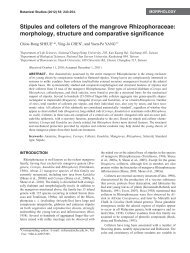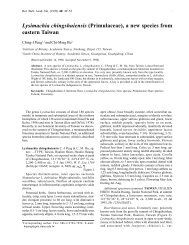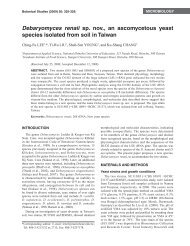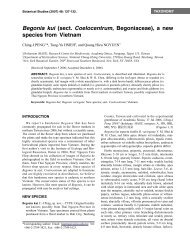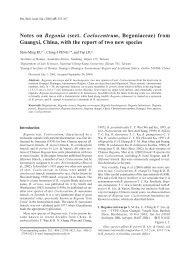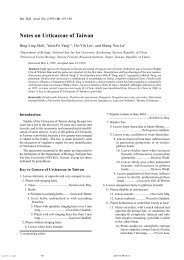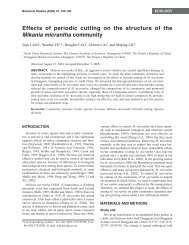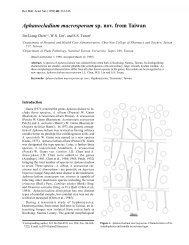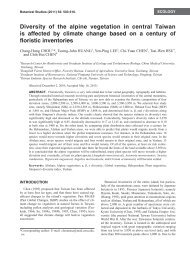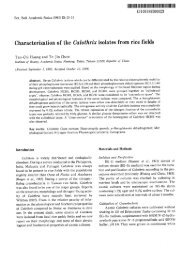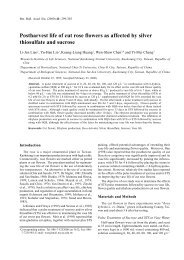Leaf, stem and crown galls on perennial asters ... - Academia Sinica
Leaf, stem and crown galls on perennial asters ... - Academia Sinica
Leaf, stem and crown galls on perennial asters ... - Academia Sinica
You also want an ePaper? Increase the reach of your titles
YUMPU automatically turns print PDFs into web optimized ePapers that Google loves.
Chen et al. — Aster gall 239<br />
Figure 1. A, Stem <str<strong>on</strong>g>and</str<strong>on</strong>g> leaf <str<strong>on</strong>g>galls</str<strong>on</strong>g> found <strong>on</strong> field grown <strong>asters</strong><br />
after cutting the floral stalk; B, Galls produced <strong>on</strong> the leaf surface<br />
of Kalanchoe pinnata after slash-inoculating the<br />
Agrobacterium suspensi<strong>on</strong>; C, Stem <str<strong>on</strong>g>galls</str<strong>on</strong>g> <strong>on</strong> seedling of tomato<br />
cultivar Known-You 301 after inoculating the Agrobacterium<br />
suspensi<strong>on</strong>; D, Stem <str<strong>on</strong>g>galls</str<strong>on</strong>g> <strong>on</strong> seedling of tobacco cultivar Xanthi<br />
NC after inoculating the Agrobacterium suspensi<strong>on</strong>; E, Gall formati<strong>on</strong><br />
<strong>on</strong> the surface of a carrot slice after inoculati<strong>on</strong> with<br />
aster Agrobacterium cells.<br />
selective NASA medium is therefore suitable for<br />
Agrobacterium isolated from aster <str<strong>on</strong>g>galls</str<strong>on</strong>g>.<br />
When leaves of healthy aster plants were inoculated<br />
with 10 Agrobacterium strains, they all produced visible<br />
small <str<strong>on</strong>g>galls</str<strong>on</strong>g> after 10 to 12 days <strong>on</strong> the wound sites (Figure<br />
2). The c<strong>on</strong>trol leaves, <strong>on</strong> the other h<str<strong>on</strong>g>and</str<strong>on</strong>g>, did not show<br />
any symptoms of <str<strong>on</strong>g>galls</str<strong>on</strong>g>. Galls <strong>on</strong> the treated leaves tended<br />
to emerge from the veins, an indicati<strong>on</strong> of Agrobacterium<br />
infecti<strong>on</strong> in the tissues active in cell divisi<strong>on</strong>.<br />
We previously reported the isolati<strong>on</strong> of A. tumefaciens<br />
from ornamental Ficus microcarpa trees (Hseu et al., 1997)<br />
in central <str<strong>on</strong>g>and</str<strong>on</strong>g> southern Taiwan. The occurrence of<br />
Agrobacterium-induced <str<strong>on</strong>g>galls</str<strong>on</strong>g> in Taiwan in <strong>perennial</strong> <strong>asters</strong><br />
has not been recorded previously. This study is perhaps<br />
the first report of <str<strong>on</strong>g>galls</str<strong>on</strong>g> from field grown <strong>asters</strong> in<br />
Taiwan. The morphology of aster Agrobacterium is simi-<br />
Figure 2. Gall formati<strong>on</strong> 10 to 12 days after re-inoculati<strong>on</strong> of<br />
aster Agrobacterium <strong>on</strong> aster leaf.



